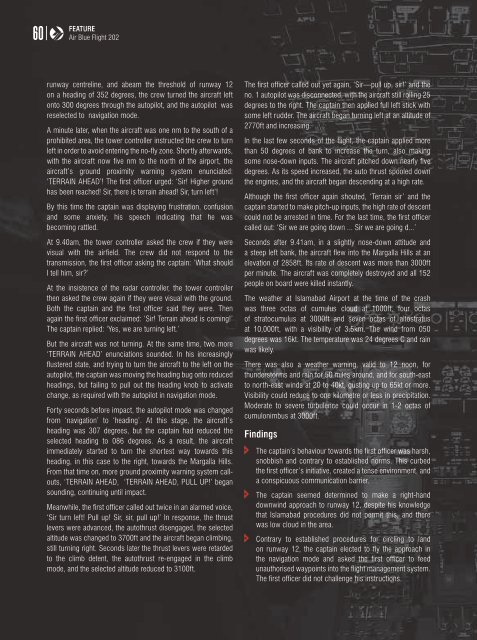jul-aug2012
You also want an ePaper? Increase the reach of your titles
YUMPU automatically turns print PDFs into web optimized ePapers that Google loves.
60<br />
FEATURE<br />
Air Blue Flight 202<br />
runway centreline, and abeam the threshold of runway 12<br />
on a heading of 352 degrees, the crew turned the aircraft left<br />
onto 300 degrees through the autopilot, and the autopilot was<br />
reselected to navigation mode.<br />
A minute later, when the aircraft was one nm to the south of a<br />
prohibited area, the tower controller instructed the crew to turn<br />
left in order to avoid entering the no-fly zone. Shortly afterwards,<br />
with the aircraft now five nm to the north of the airport, the<br />
aircraft’s ground proximity warning system enunciated:<br />
‘TERRAIN AHEAD’! The first officer urged: ‘Sir! Higher ground<br />
has been reached! Sir, there is terrain ahead! Sir, turn left’!<br />
By this time the captain was displaying frustration, confusion<br />
and some anxiety, his speech indicating that he was<br />
becoming rattled.<br />
At 9.40am, the tower controller asked the crew if they were<br />
visual with the airfield. The crew did not respond to the<br />
transmission, the first officer asking the captain: ‘What should<br />
I tell him, sir?’<br />
At the insistence of the radar controller, the tower controller<br />
then asked the crew again if they were visual with the ground.<br />
Both the captain and the first officer said they were. Then<br />
again the first officer exclaimed: ‘Sir! Terrain ahead is coming!’<br />
The captain replied: ‘Yes, we are turning left.’<br />
But the aircraft was not turning. At the same time, two more<br />
‘TERRAIN AHEAD’ enunciations sounded. In his increasingly<br />
flustered state, and trying to turn the aircraft to the left on the<br />
autopilot, the captain was moving the heading bug onto reduced<br />
headings, but failing to pull out the heading knob to activate<br />
change, as required with the autopilot in navigation mode.<br />
Forty seconds before impact, the autopilot mode was changed<br />
from ‘navigation’ to ‘heading’. At this stage, the aircraft’s<br />
heading was 307 degrees, but the captain had reduced the<br />
selected heading to 086 degrees. As a result, the aircraft<br />
immediately started to turn the shortest way towards this<br />
heading, in this case to the right, towards the Margalla Hills.<br />
From that time on, more ground proximity warning system callouts,<br />
‘TERRAIN AHEAD, ‘TERRAIN AHEAD, PULL UP!’ began<br />
sounding, continuing until impact.<br />
Meanwhile, the first officer called out twice in an alarmed voice,<br />
‘Sir turn left! Pull up! Sir, sir, pull up!’ In response, the thrust<br />
levers were advanced, the autothrust disengaged, the selected<br />
altitude was changed to 3700ft and the aircraft began climbing,<br />
still turning right. Seconds later the thrust levers were retarded<br />
to the climb detent, the autothrust re-engaged in the climb<br />
mode, and the selected altitude reduced to 3100ft.<br />
The first officer called out yet again, ‘Sir—pull up, sir!’ and the<br />
no. 1 autopilot was disconnected, with the aircraft still rolling 25<br />
degrees to the right. The captain then applied full left stick with<br />
some left rudder. The aircraft began turning left at an altitude of<br />
2770ft and increasing.<br />
In the last few seconds of the flight, the captain applied more<br />
than 50 degrees of bank to increase the turn, also making<br />
some nose-down inputs. The aircraft pitched down nearly five<br />
degrees. As its speed increased, the auto thrust spooled down<br />
the engines, and the aircraft began descending at a high rate.<br />
Although the first officer again shouted, ‘Terrain sir’ and the<br />
captain started to make pitch-up inputs, the high rate of descent<br />
could not be arrested in time. For the last time, the first officer<br />
called out: ‘Sir we are going down ... Sir we are going d...’<br />
Seconds after 9.41am, in a slightly nose-down attitude and<br />
a steep left bank, the aircraft flew into the Margalla Hills at an<br />
elevation of 2858ft. Its rate of descent was more than 3000ft<br />
per minute. The aircraft was completely destroyed and all 152<br />
people on board were killed instantly.<br />
The weather at Islamabad Airport at the time of the crash<br />
was three octas of cumulus cloud at 1000ft, four octas<br />
of stratocumulus at 3000ft and seven octas of altostratus<br />
at 10,000ft, with a visibility of 3.5km. The wind from 050<br />
degrees was 16kt. The temperature was 24 degrees C and rain<br />
was likely.<br />
There was also a weather warning, valid to 12 noon, for<br />
thunderstorms and rain for 50 miles around, and for south-east<br />
to north-east winds at 20 to 40kt, gusting up to 65kt or more.<br />
Visibility could reduce to one kilometre or less in precipitation.<br />
Moderate to severe turbulence could occur in 1-2 octas of<br />
cumulonimbus at 3000ft.<br />
Findings<br />
The captain’s behaviour towards the first officer was harsh,<br />
snobbish and contrary to established norms. This curbed<br />
the first officer’s initiative, created a tense environment, and<br />
a conspicuous communication barrier.<br />
The captain seemed determined to make a right-hand<br />
downwind approach to runway 12, despite his knowledge<br />
that Islamabad procedures did not permit this, and there<br />
was low cloud in the area.<br />
Contrary to established procedures for circling to land<br />
on runway 12, the captain elected to fly the approach in<br />
the navigation mode and asked the first officer to feed<br />
unauthorised waypoints into the flight management system.<br />
The first officer did not challenge his instructions.

















